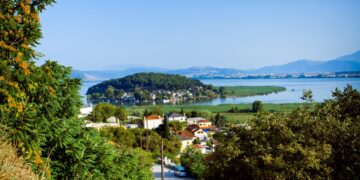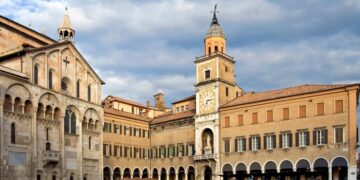Without a doubt, Sibiu is one of Romania’s most charming cities. And no holiday in Transylvania would be complete without at least a few hours in this wonderful city, former European Capital of Culture in 2007 and nicknamed “Little Vienna” by the famous Michelin Guide.
Many go so far as to call Sibiu the most beautiful city in Romania. These rankings are always subjective, but surely, at least in the top five, Sibiu automatically makes it, without any emotion. A rich historical past, some important architectural landmarks, punctuated by the famous “eye” roofs, as well as an intense cultural life, marked by events and festivals of all kinds, make Sibiu a beautiful city, well managed by the mayors of recent years, and much sought after by both Romanian and foreign tourists.
In the following, we will review some of the most beautiful attractions and sights in Sibiu, coming precisely to meet tourists who want to know what to see and do in the Transylvanian city.
- History of Sibiu
- The most beautiful tourist attractions in Sibiu
- The Great Square
- The Council Tower
- Brukenthal Palace / Brukenthal National Museum
- Holy Trinity Roman Catholic Church, Holy Trinity Cathedral, Lutheran Church
- Small Square
- Bridge of Lies
- The Passage of Stairs, Staircase Tower, and Huet Square
- Nicolae Bălcescu Street
- Astra Museum
- Sibiu Public Bath
- Tourist attractions for children in Sibiu. What to do with children in Sibiu
- Best hotels in Sibiu
- Best restaurants in Sibiu
- Pin it!
History of Sibiu
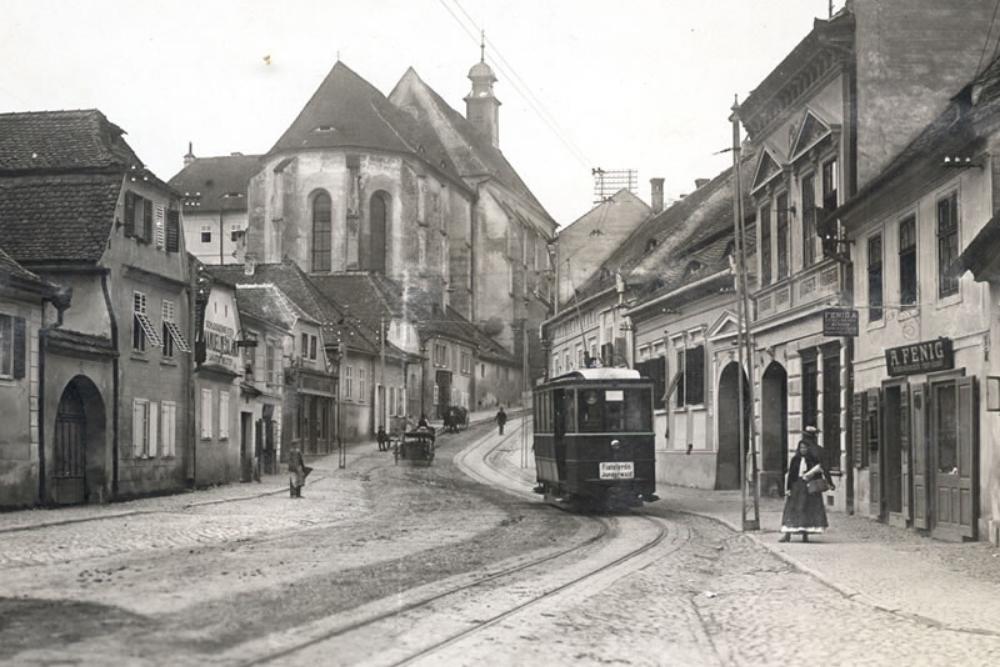
Sibiu has a population of 167,000 inhabitants (2021) and is located on the Cibin River, in the southern part of Transylvania, more precisely in the Depression of Sibiu. The city’s history begins somewhere in the 12th century, with the colonization by the Saxons, according to some sources, even earlier, since the presence of a human settlement was reported here before this date. More precisely, from the time of the Daco-Romans, when there was Cibinium/Cibiensis, a settlement that took its name from the river’s name. However, suppose we refer to official documents, the first documentary evidence of Sibiu dates back to 20 December 1191, when Pope Celestine III confirmed the existence of the German prefecture in Transylvania in this settlement.
By the end of the 14th century, the town had become an important commercial center, with 19 guilds recorded in 1376. Sibiu, known in the Middle Ages as Siebenbürgen (Seven Cities), Hermannsdorf, and later Hermannstadt, was the easternmost European city with an ethnic German population.
However, Sibiu was to experience its heyday after 1692, when it was designated the capital of Transylvania, a principality that was part of the Habsburg Empire. Although the King of Hungary was formally the ruler of Transylvania, he did not do so directly but through a Governor based in Sibiu (source). For 100 years, Sibiu held this position, losing its status to Cluj in 1791.
The middle of the 19th century found Sibiu at the center of the struggle for national liberation of the Romanians, and the years that followed were of intense economic and cultural prosperity for the city. In 1863 an important event took place with the adoption of the Sibiu Diet. It was a law on the equal rights of the Romanian nation and its confessions and (in 1865) the law for using the Romanian language in justice and administration on an equal footing with the Hungarian German languages.
Sibiu became the capital of Transylvania again after the Great Union of 1918, a position it held for one year. In 1919 it was renamed as such (until then, the city had been called Hermannstadt or Nagyszeben in German or Hungarian).
The most beautiful tourist attractions in Sibiu
Map with the main tourist attractions of Sibiu (zoom in for details)
The Great Square
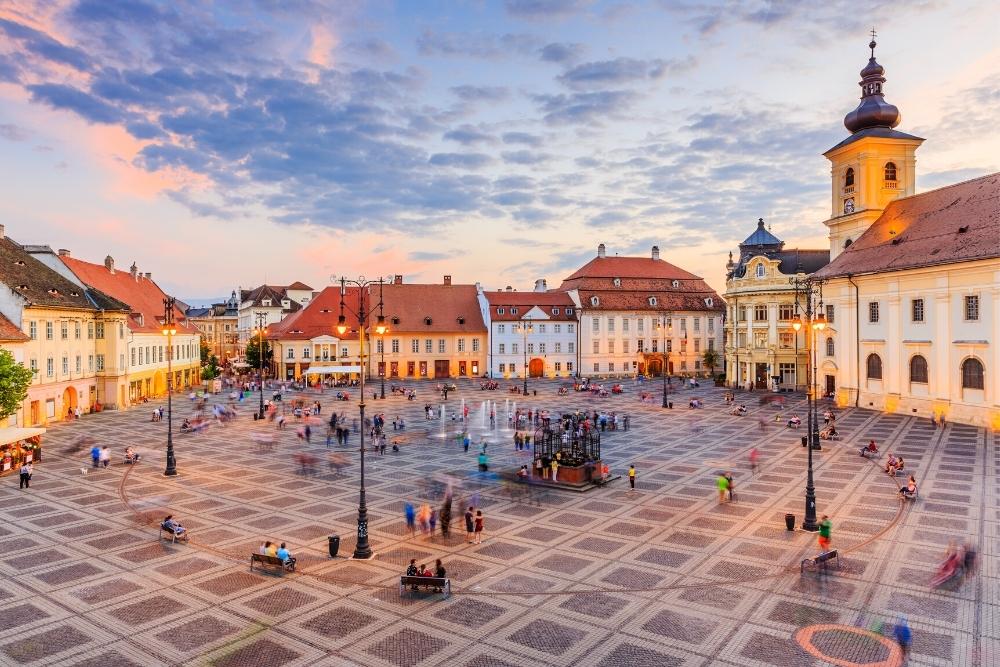
Sibiu’s central square had existed since 1366 when the construction of the city’s third fortification belt was completed. It is the place that somewhat defines the city of Sibiu. A kind of “kilometer zero” that had various names over the ages, from Gressoer Platz, as the Saxons called it, to King Ferdinand Square (during the interwar period), from Republic Square (during the communist period) to the Great Square (after 1990).
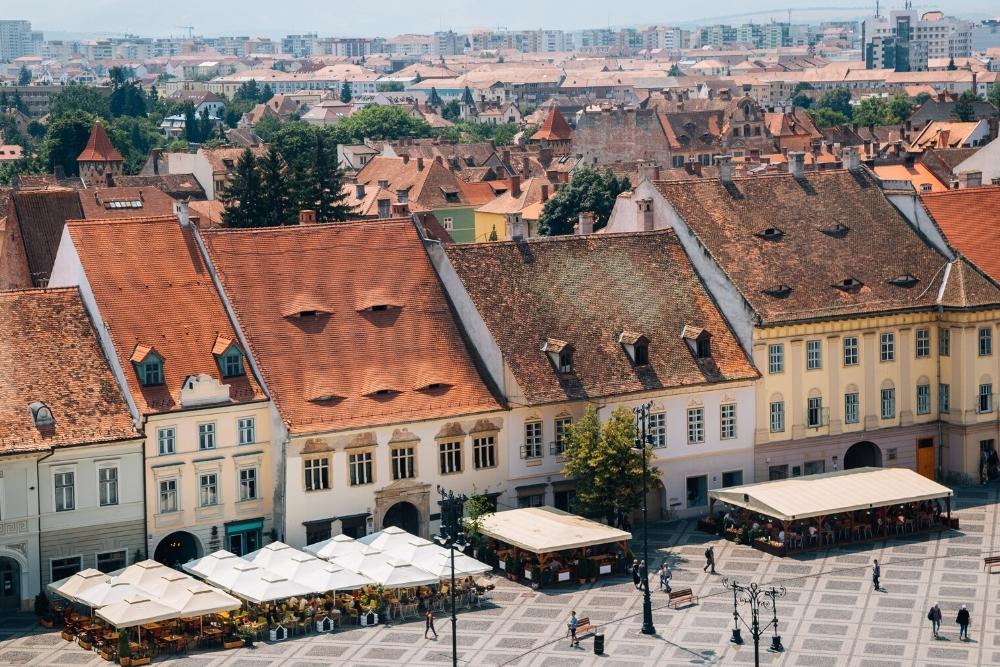
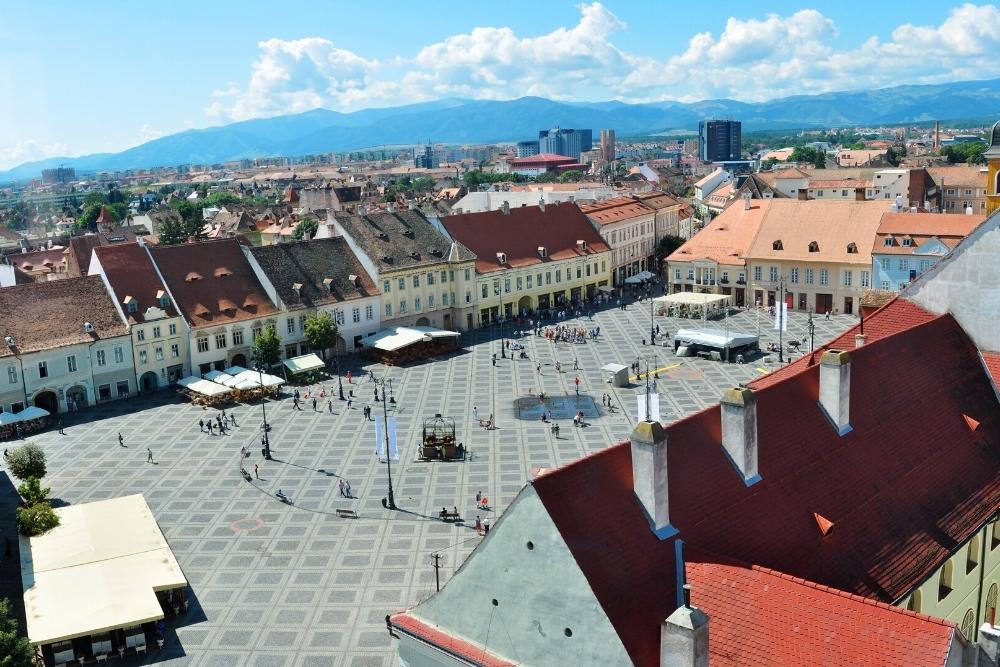
A large square (142 x 93 meters, one of the largest in Transylvania), the Grand Square is bordered by important city buildings, including the well-known “houses with eyes”. The Jesuits’ Byzantine House, the Blue House, the Council Tower, the Haller House, and the Hecht House, the Filek Palace, the House of the Generals, the Lutsch House, and the Brukenthal Palace are the main “pearls” of this square, which preserves the architecture of the 18th-19th centuries and has undergone extensive renovation work.
Throughout its history, the Grand Square has witnessed many events that were part of the daily life of Sibiu. For example, in 1550, a pillar of infamy was erected here, where outlaws caught in the act were tied up, as well as gallows (at number 15), removed in 1783. In 1703 Johann Sachs von Harteneck, a Saxon committee for 12 years, was beheaded in the Great Square.

Today, we can say that the Main Square is the main tourist attraction in Sibiu, the place where sooner or later all visitors to the city “land”, to take photos or to relax at one of the terraces that surround it. Also, the main square is the main venue for the Christmas Fair, which has become a landmark of Christmas festivals in Romania.
The Council Tower
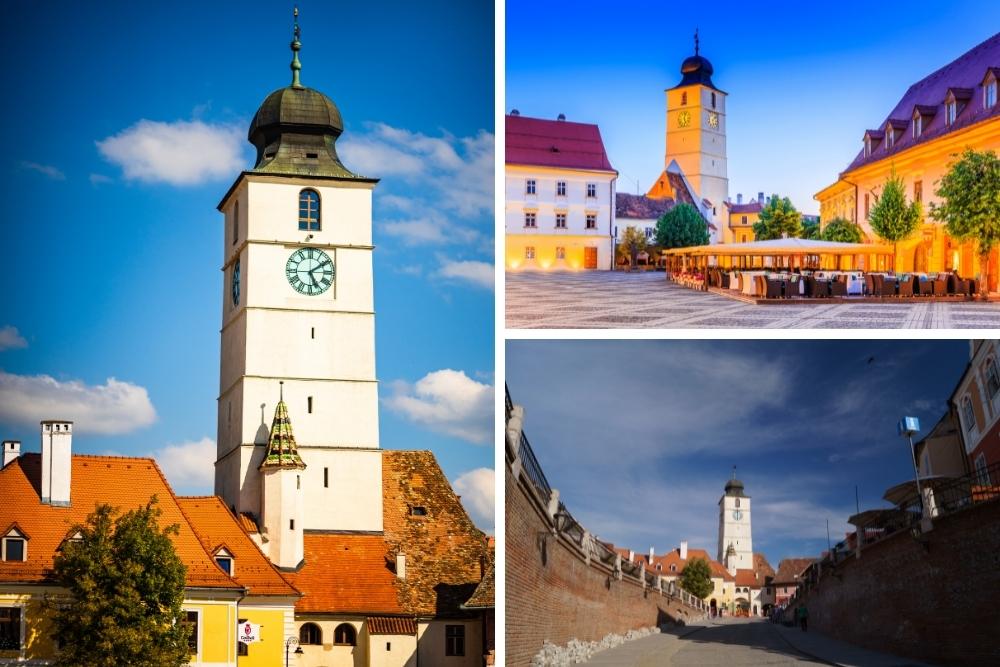
The Council Tower is an important landmark of Sibiu and a symbol of the city. Built in the 13th century (between 1224 and 1241), it was originally part of the second fortification enclosure, playing the role of a defense tower and entrance gate. In 1585 it was largely damaged by an earthquake. It was rebuilt three years later and subsequently put to various uses, from a warehouse to prison and museum. Its present form dates from 1824-1826, when the tower’s appearance was changed from a pyramidal roof with four turrets to the present one. Today it links the Small Square and the Big Square.
Access to the Council Tower is made through a small doorway leading to a spiral staircase. To reach the top floor, you have to climb 141 steps, stopping to admire the clock mechanism on the penultimate level, installed on 19 December 1906 by the J.J. company. Fuchs and Sons of Bernberg. From the top, you have a beautiful view of the old center of Sibiu.
The Council Tower can be visited from Tuesday to Sunday from 10 am to 6 pm. The entrance ticket costs 2 lei.
Brukenthal Palace / Brukenthal National Museum
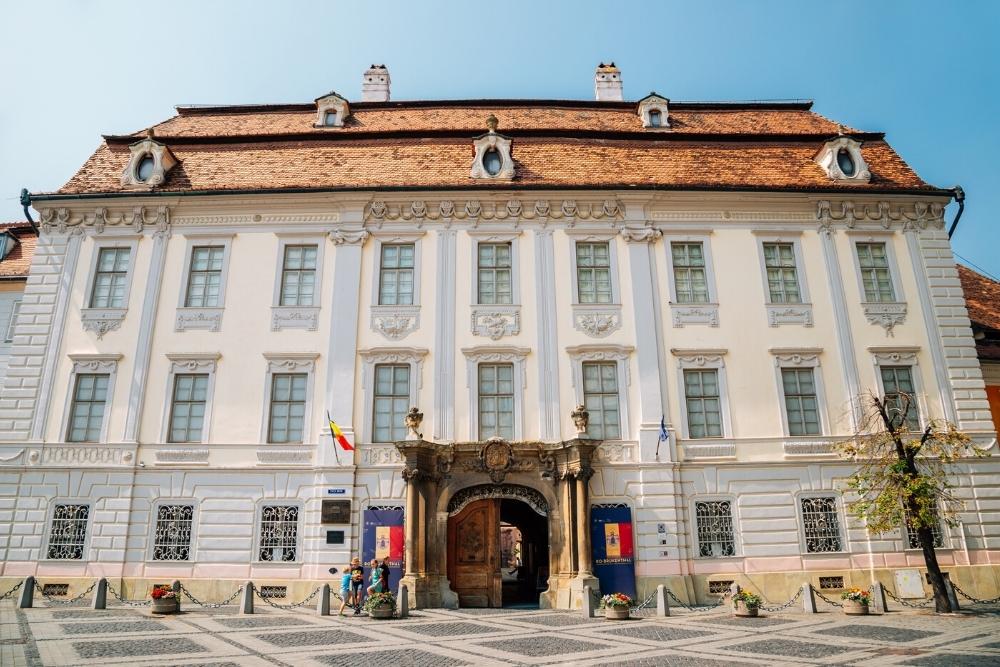
Samuel von Brukenthal (1721-1803) was a Saxon baron to whom Empress Maria Theresa assigned important public functions within the Austrian state. The most prominent of these was that of the Chancellor of Transylvania. Brukenthal was a great art lover and an accomplished collector. This is why he managed to amass a great many works of art during his time in Vienna, which became the most valuable private collection of those years (1759-1774).
Brukenthal was appointed Governor of the Grand Principality of Transylvania in 1777 (until 1787). During that time, under his instructions, a majestic palace was built in Sibiu, on the western side of the Piazza Mari, in late Baroque style, similar to the palaces in the Austrian capital. Today this is the Brukenthal Palace in Sibiu, now the Brukenthal National Museum.
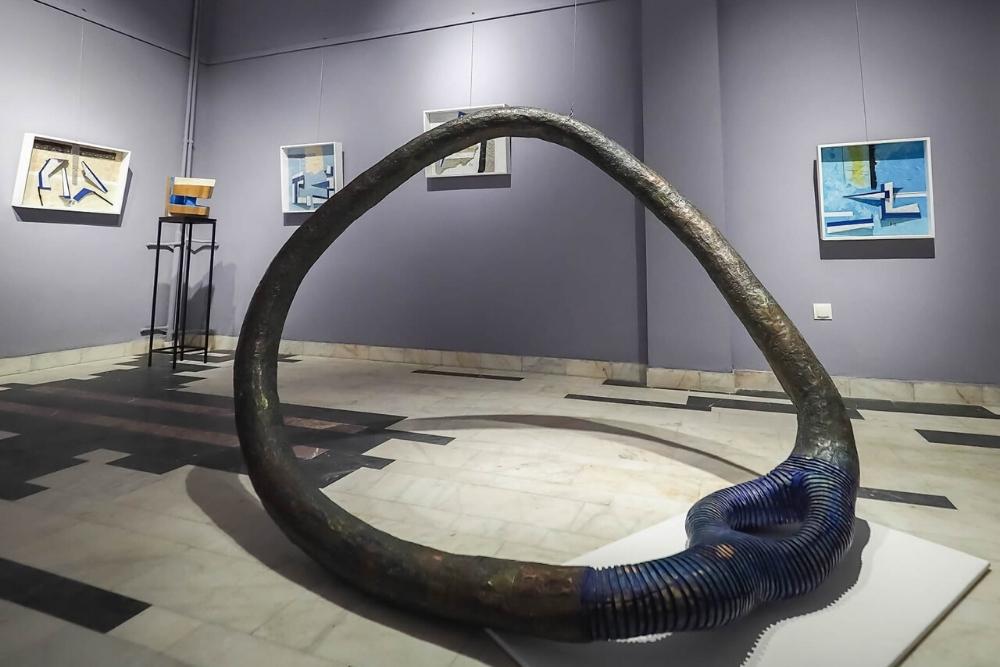
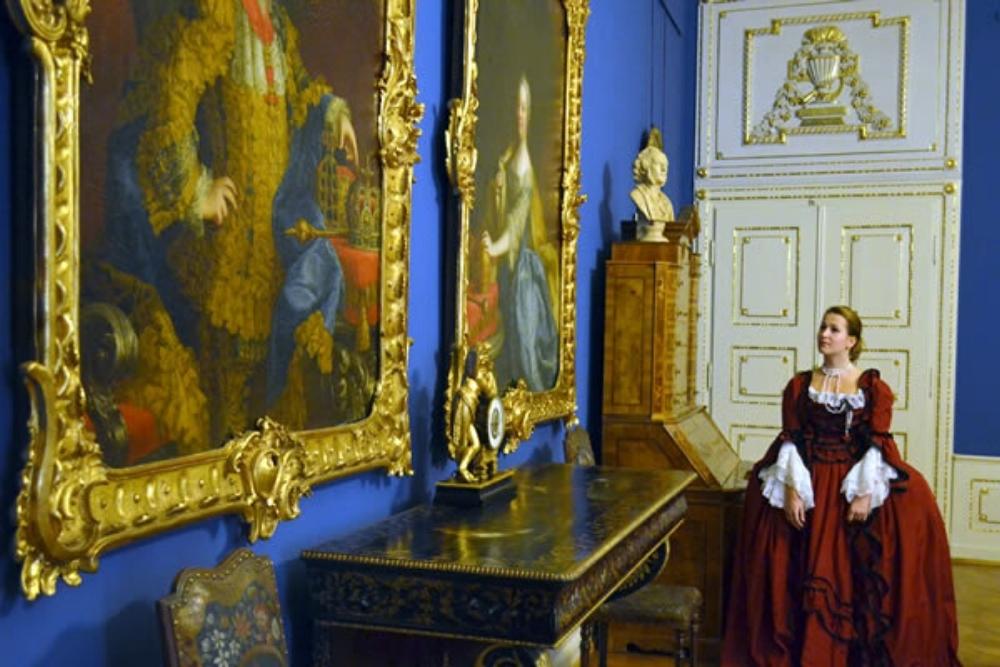
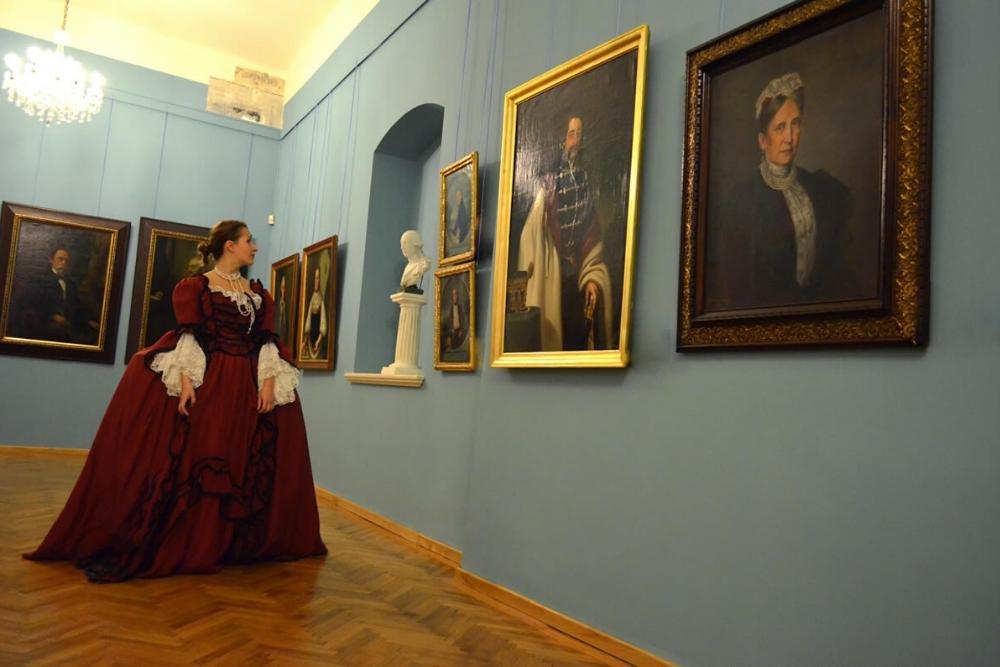
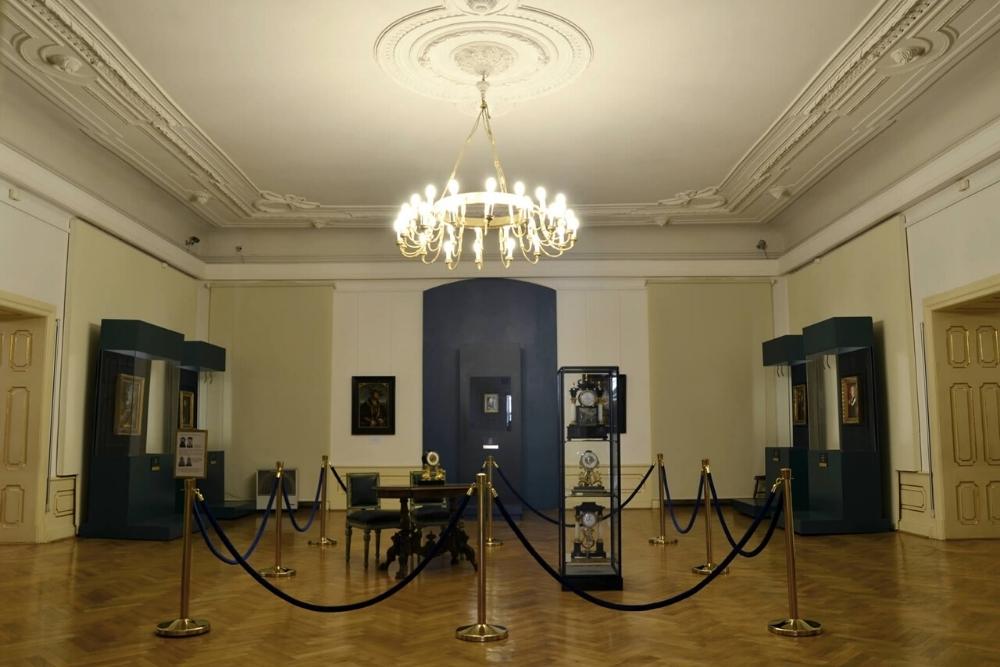
The palace was originally the Baron’s residence, housing his immense art collection. But Brukenthal wanted the world to be able to admire this collection, so in 1790, three years before the Louvre opened, he welcomed guests who wished to cross his threshold. The idea then took off, and in 1817 the museum officially opened, making Brukenthal the oldest museum in Romania and one of the oldest in Eastern Europe.
Beyond the impressive architecture of the palace, which impresses visitors both inside and out, they will be fascinated by the collections in the Art Gallery (European, Romanian and contemporary) and the National Museum Library. Nicolae Grigorescu, Ștefan Luchian, Nicolae Tonitza, Theodor Aman, Corneliu Baba, Pieter Bruegel, Hans Memling, Jan van Eyck, and many others are the artists whose works can be found in the Brukenthal National Museum.
Visiting hours are Wednesdays to Sundays from 9 am to 5 pm. Entrance tickets have different prices, depending on what you want to visit – you can see them here.
Holy Trinity Roman Catholic Church, Holy Trinity Cathedral, Lutheran Church
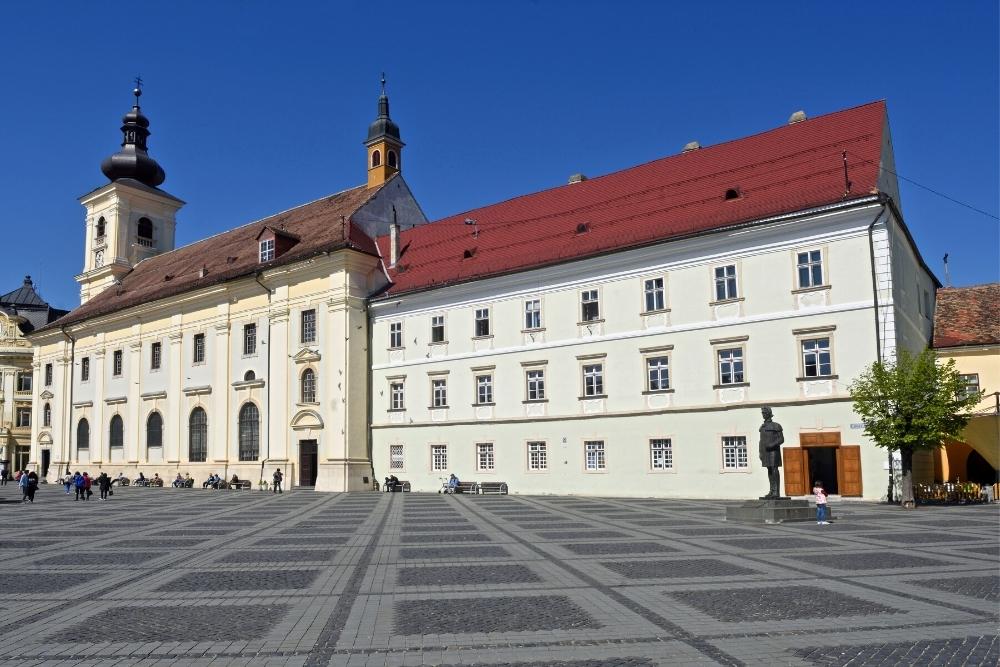
Also in the main square is the Roman Catholic Church of the Holy Trinity, built between 1726 and 1733 by the Jesuits in the early Viennese Baroque style. The Jesuits also built a statue of St Nepomuk at that time, which they placed in the Great Square, but which was removed by the communist regime. However, the statue did not disappear, and today it can be admired in the churchyard.
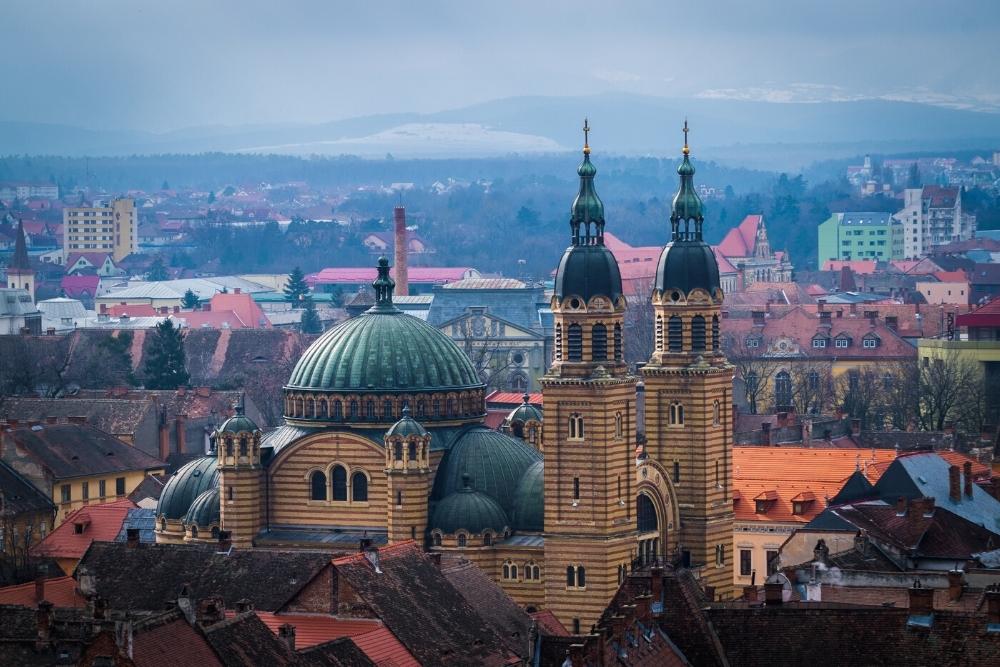
The Holy Trinity Cathedral is an Orthodox church built between 1902 and 1906 on the initiative of Metropolitan Ioan Metianu on the site of an old Greek church that had served as an Episcopalian cathedral (source). It is a small-scale copy of St Sophia’s Church in Istanbul. Inside the magnificent dome is a painted image of Christ flanked by angels above the gilded wooden iconostasis. Both are the work of the eminent Transylvanian symbolist Octavian Smigelschi.
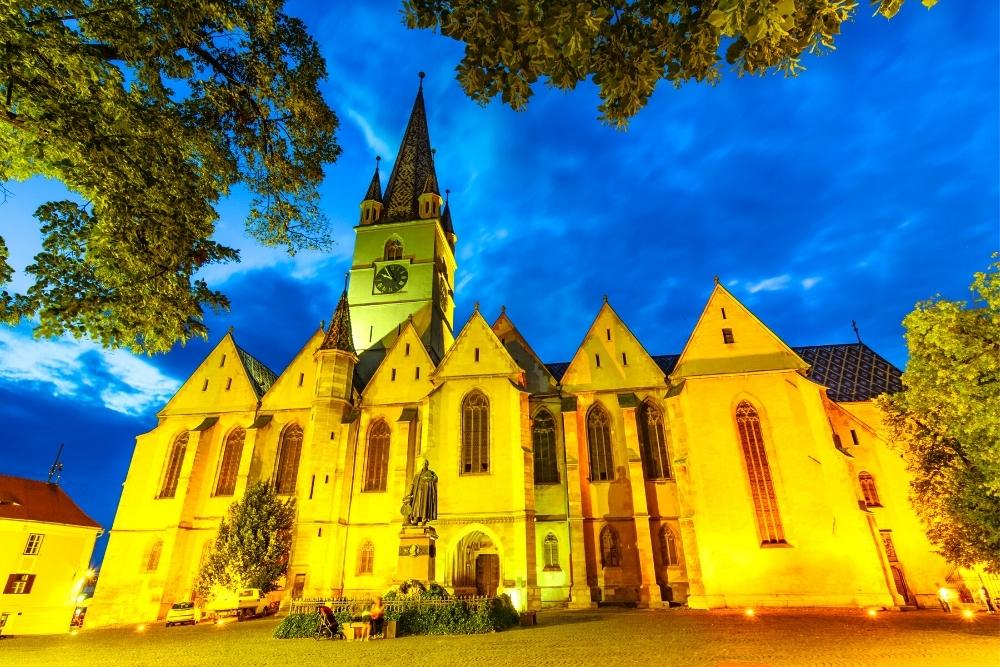
The Lutheran Church is a remarkable Gothic building whose construction began in 1371 and was completed in 1520. Its distinctive seven-storey tower is 73.34 meters high, making it the tallest building in Sibiu. You can climb the 192 steps of the tower, reaching the four smaller towers, from where you can photograph a beautiful view of the city.
Inside the church, you will discover a bas-relief of Jesus on the Mount of Olives, carved towards the end of the 15th century, and the narthex, transformed into a chapel of its own in the mid-19th century, lined with monuments and tombstones of prominent personalities of Sibiu.
The tower can be visited daily from 10 am to 8 pm (July to September) and only on Saturdays and Sundays from 10 am to 5 pm (October to June). Ticket price: 3 lei.
Small Square
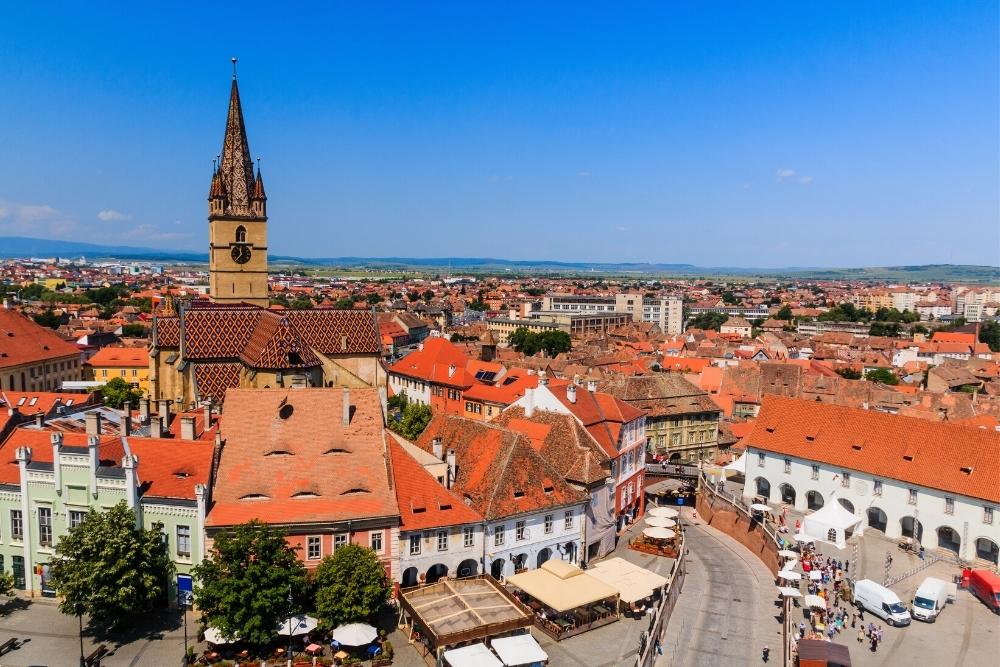
Built in the 14th century, in the middle of the city’s second fortification, the Small Market was for a long time the main public market of Sibiu, the first documentary evidence of which mentions the presence of numerous butcher’s shops. After the butchers, the tailors were the ones who took over the commercial spaces of the Small Market, and in the 15th century, shoemakers joined them.
The square is surrounded by numerous historic buildings of heritage importance, most of which have semicircular arches supported by pillars. Several important cultural events are organized in the Small Square, the most famous being the Sibiu Theatre Festival, but also the Book festival and the Metropolis Caravan.
Bridge of Lies
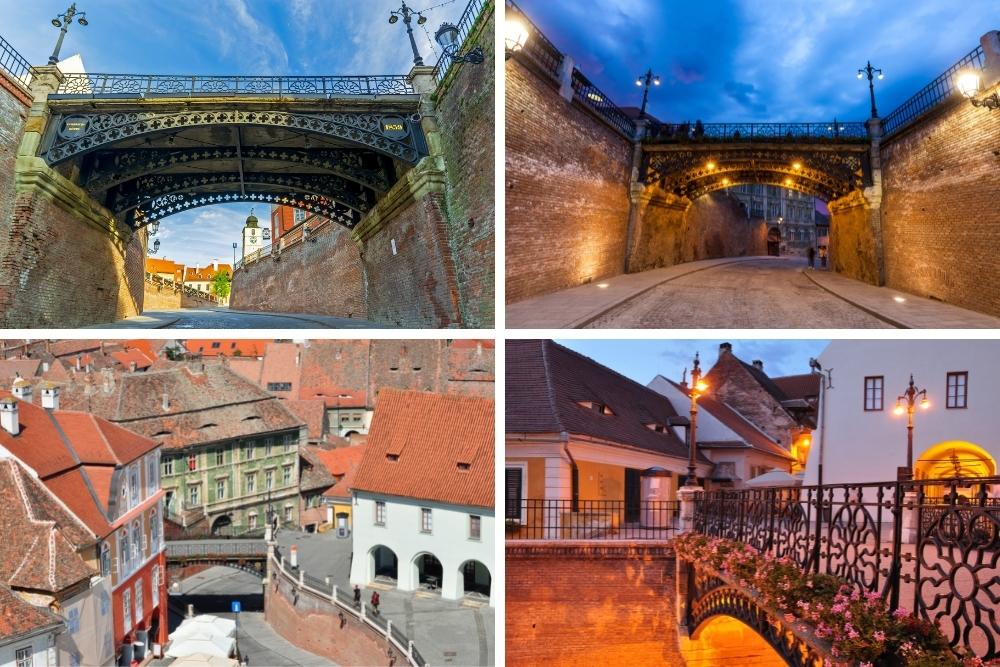
The Bridge of Lies is probably one of the most famous sights in Sibiu; this fact comes both from the name itself and from the legends that define it. The bridge, which connects the Small Square and the Huet Square, took its present form in 1859, after replacing the old wooden bridge to become the first cast-iron bridge in Romania and the first not to be built on pillars. It is 10.40 meters long.
For this reason, the pedestrian bridge was originally called the Lying Bridge (Liegenbrücke in German), hence the confusion over the current name, Lügenbrücke being the German word for lie. Architecturally, it is notable for its two vaulted metal transoms, which include two representative decorative circles, and for its radially decorated balustrades in the Gothic style.
The best-known legend about the bridge is that a lie told by someone who is currently on it will cause the bridge to collapse. Another legend tells of young lovers walking across the bridge, swearing eternal love. The girls swore they were untouched, but if, after the wedding night, they were proved to have lied, they would be thrown off the bridge. Another saying about the Bridge of Lies is that it had ears. And if it hears that someone has lied, it will start shaking at the knuckles and throw the liar to the ground.
The Passage of Stairs, Staircase Tower, and Huet Square
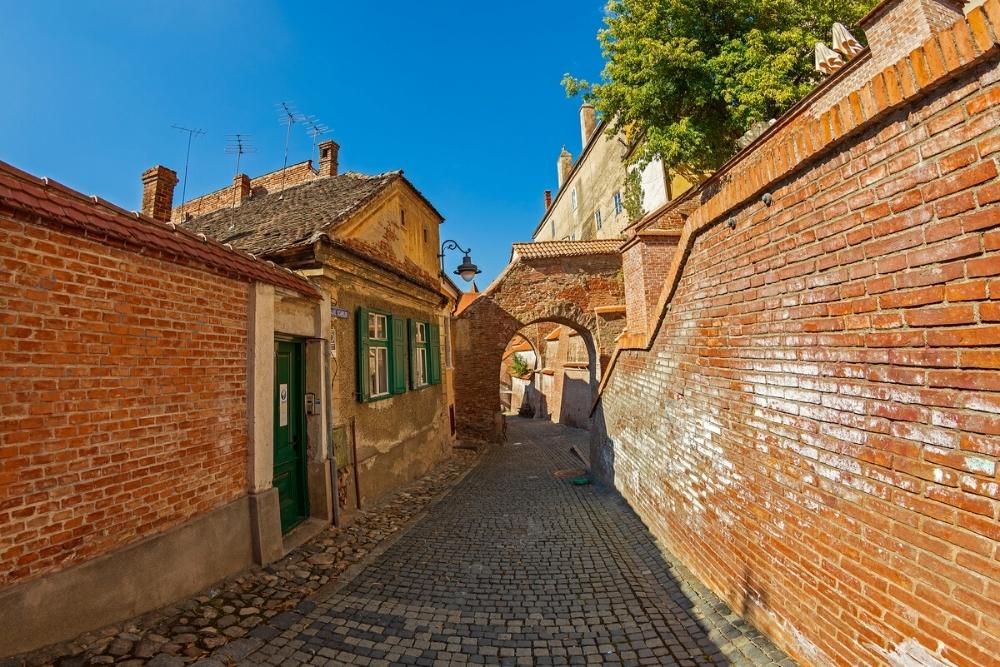
Built in the 14th century of brick and stone as part of Sibiu’s third belt of fortifications, the Passage of Stairs (or Needle Wall, as it was called) linked the Upper and Lower Towns with a winding slope designed for the ox carts of the time.
Degraded over time, the passage was restored twice, in 1860 and then in 2006. Along the Stairs Passage are four houses built in the 15th-16th centuries, which have also been restored and are now listed as historical monuments in Sibiu. The most photogenic section of the passage is below the Lutheran Cathedral, and amateur photographers or casual tourists should come here to catch some fantastic light in the summer months before sunset.
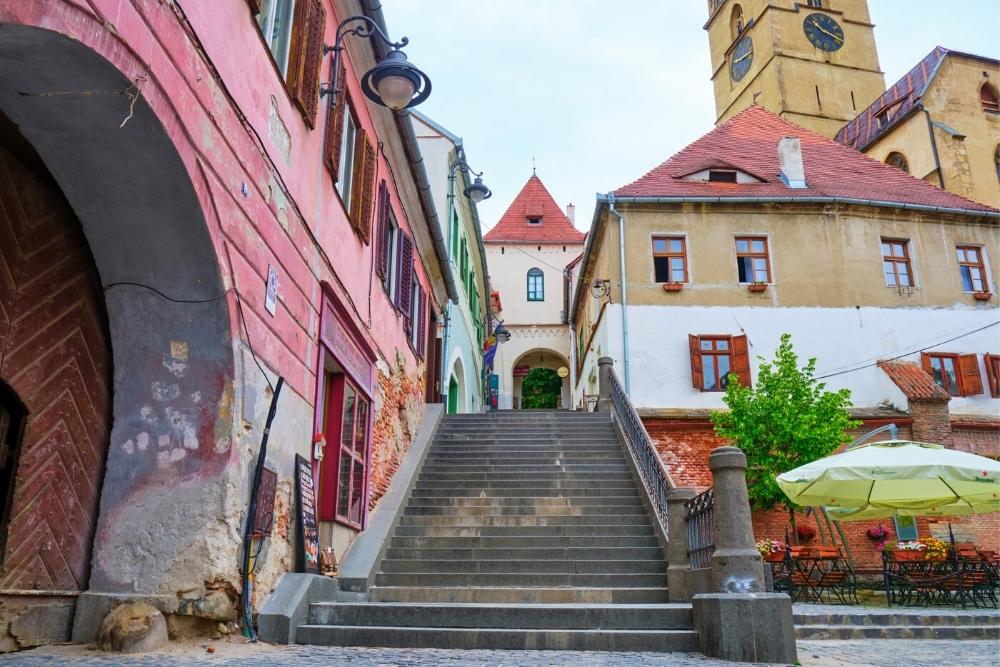
The Tower of Stairs, on the other hand, erected in the 13th century, is considered the oldest building in Sibiu, originally belonging to the city’s first fortification enclosure. It is located in the Huet Square and, thanks to its vaulted archway, allows access to the Lower Town via steps called the Sag Stairs.

And speaking of Huet Square, this perimeter around the Lutheran Cathedral, marked by buildings from the 15th-18th centuries, will inevitably be crossed by anyone visiting Sibiu’s old town. This is where the city’s first fortifications were built. As mentioned above, we find the Staircase Tower, the Calf House, the Parish House, and the Brukenthal High School (completed in 1776 built on the site of a 14th-century school).
Nicolae Bălcescu Street
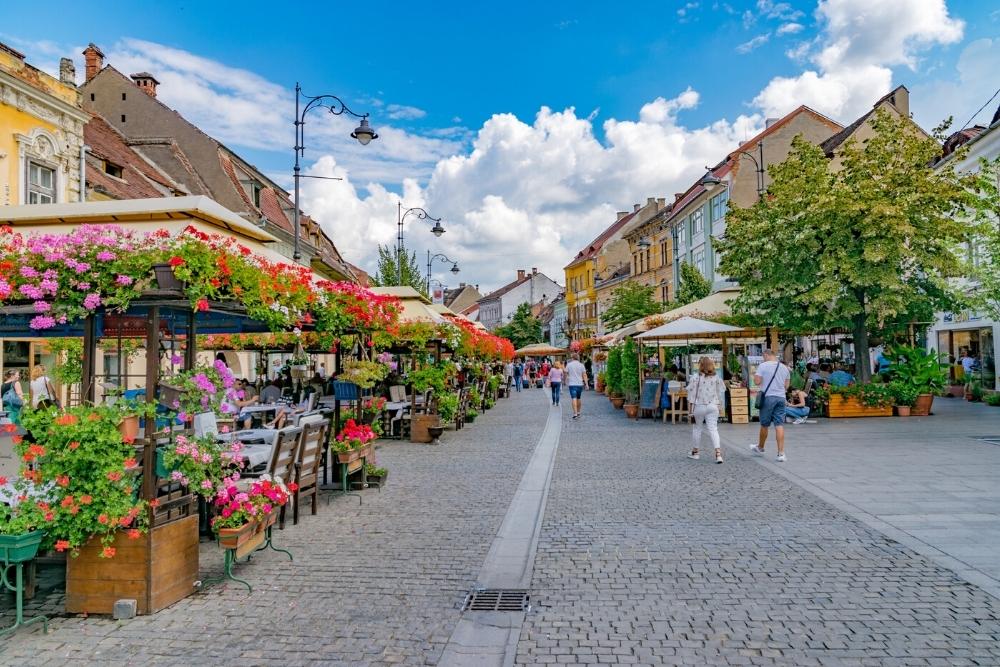
Sibiu’s main pedestrian thoroughfare, Nicolae Bălcescu Street, which stretches from Union Square to the Great Square, was first mentioned in 1492, with the name Platea Heltensis, in a work by Emil Sigerus, ethnographer, collector, historian, and writer from Transylvania. Over the years, the street has had several names, from Strada Cisnădiei (1875) to Strada Franz Josefgasse (1917), Strada Regina Maria (1919-1947), and Strada I.V. Stalin (1947-1970).
Nicolae Bălcescu is the street where every bohemian tourist comes to Sibiu to taste ice cream, go shopping, or just waste time admiring the pastel-colored buildings built in the 17th-19th centuries. On this street is, among others, the building of the Hotel Emperor of the Romans, one of the best known and most representative hotels in Sibiu, documented in 1555 and inaugurated under this name on 31 May 1783, with the visit of Emperor Joseph II of the Austro-Hungarian Empire.
Astra Museum
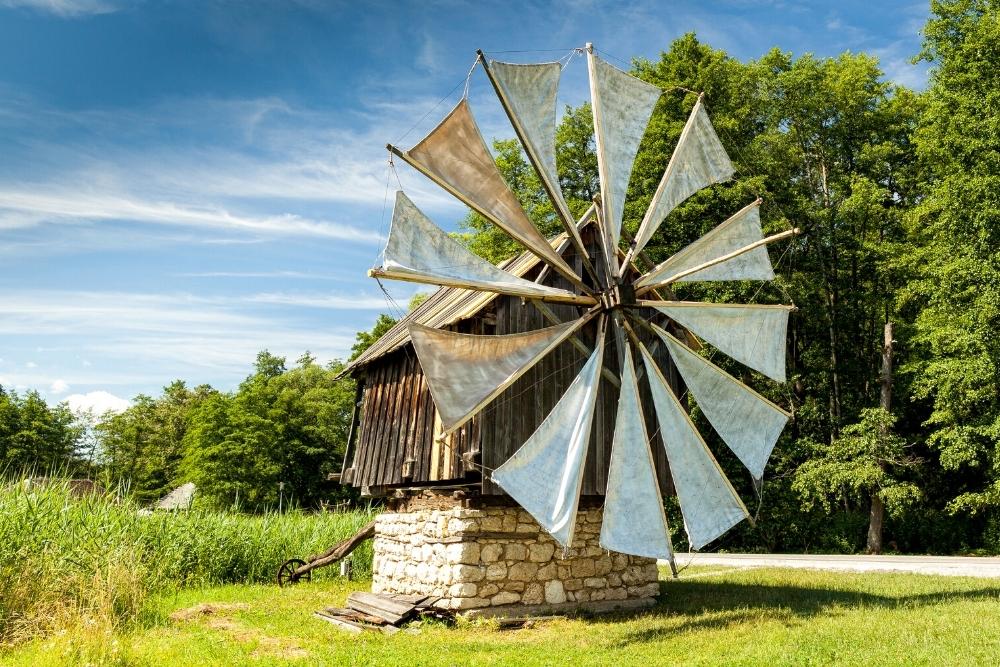
The Astra National Museum Complex is located 4 km from Sibiu, in Dumbrava Sibiului. It is one of the “must-see” tourist attractions both for those on family holidays and for backpackers. The Astra Museum is arguably the most important ethnic museum in Romania. The arguments supporting this claim are well-founded.
With a history that begins on 19 August 1905, when the first exhibition of the Museum of the Association, as it was originally called, took place, the Astra Museum was born out of the desire to define Romanian ethnocultural identity amid the Austro-Hungarian space. In 1963, the Museum of Folk Technology was founded here, a revival of the old museum that had been closed in 1950. The first exhibit was a hydraulic mill, but the collection was rapidly enriched, and in 1971 peasant households were added.
Today, the open-air museum covers 96 hectares around a lake, with 10 kilometers of paths where visitors can stroll in peace, take a horse-drawn carriage ride or, in winter, go on sleigh rides.
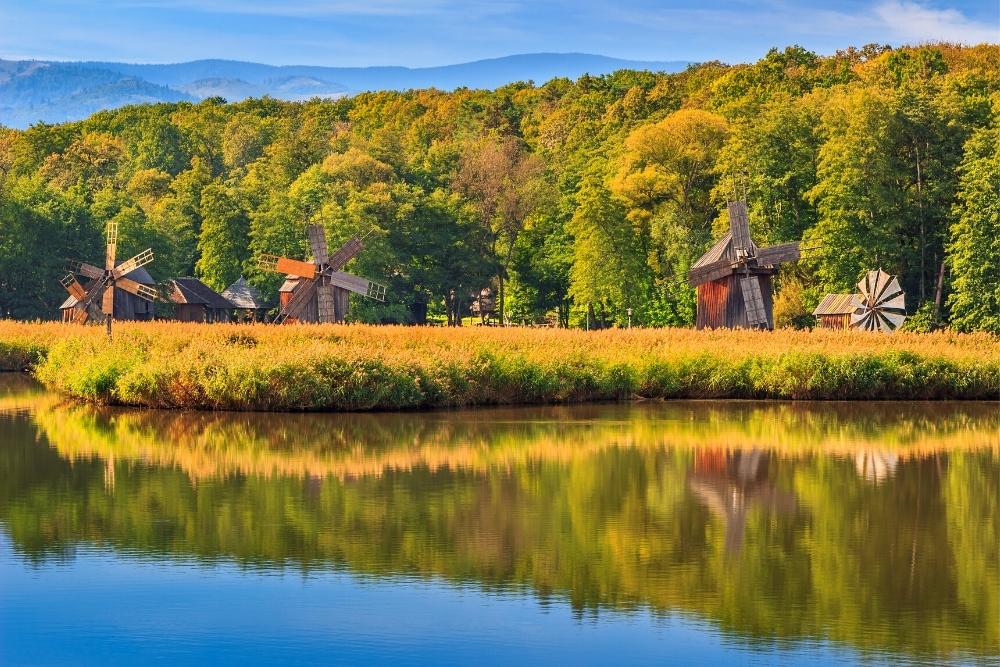
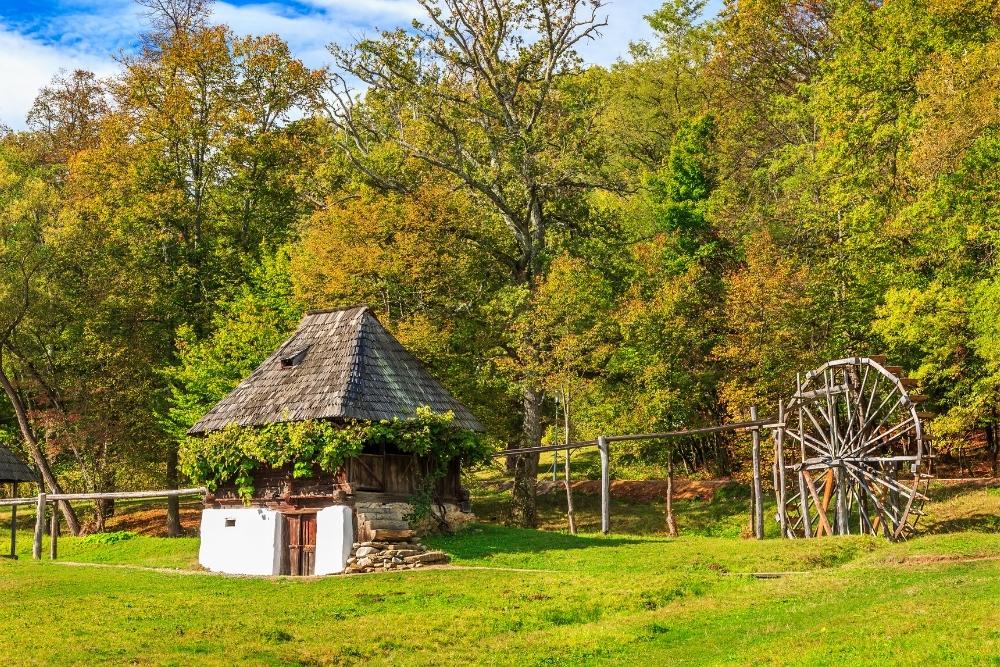
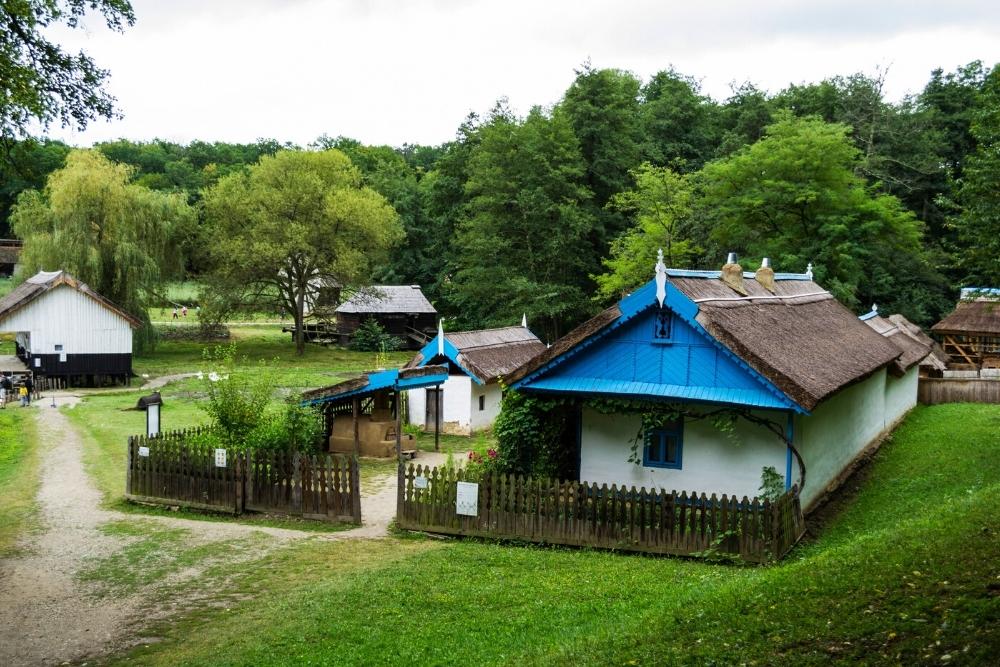
The exhibits include traditional peasant farms, wind, and watermills, wooden churches, workshops, and stables, highlighting rural life from all over Romania, both inside and out. There are over 300 buildings and more than 16,000 exhibits to delight visitors, who can enjoy various leisure activities, accommodation (53 places), restaurants, inns, and playgrounds. In addition, cultural events take place in the open-air museum every week. The Astra Museum is divided into four museum areas: the open-air museum, the Museum of Transylvanian Civilisation, the Emil Sigerul Museum, and the Franz Binder Museum.
A visit to the Astra Museum is an unforgettable experience, whether you want to take a walk in a beautiful park on a beautiful day or whether you want to find out useful and interesting things about living in the countryside and the customs of rural Romanians.
Astra Museum address: 16-20 Pădurea Dumbrava Street. Opening hours: 8am – 6pm. Prices: 35 lei (adults), 9 lei (pupils/students), 15 lei (pensioners).
Sibiu Public Bath
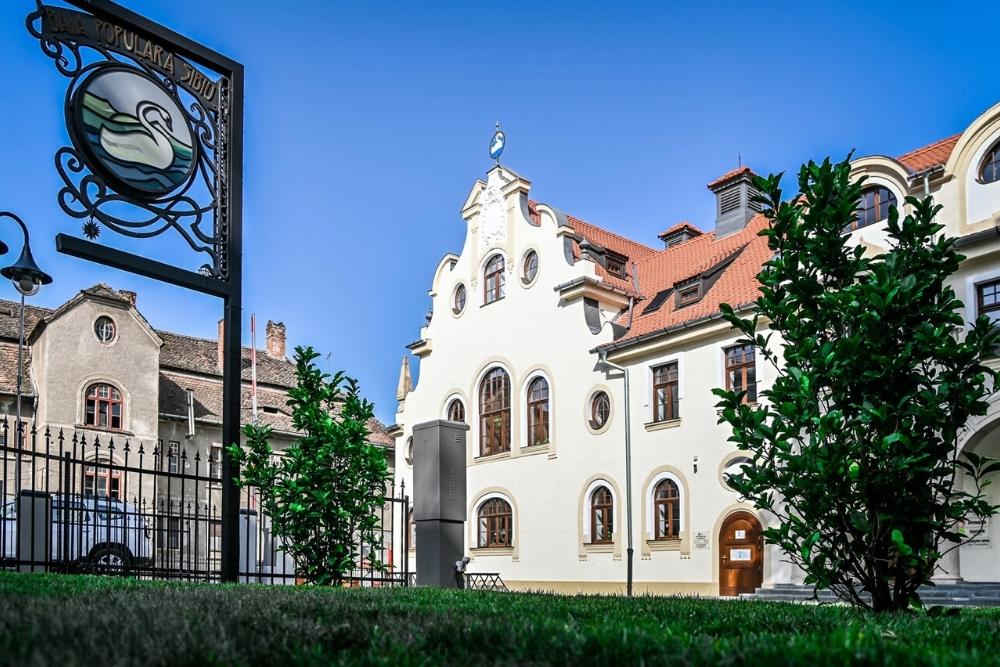
In 1840, the first stearin candle factory in Transylvania opened in Sibiu. However, it was quickly moved to another area, which led Franz Frühbeck senior to set up the first steam baths in its place, bought in 1886 by Johann Habermann. He expanded and modernized it, moving it to the site of today’s Paediatric Hospital.
Doctor Carl Wolff then had the idea, at the end of the 19th century, to build a communal bath accessible to the inhabitants of Sibiu. It was put into practice in the form of a building combining Baroque and Jugendstil of the time, inaugurated on 11 December 1904. Thus was born the Sibiu Public Bath, a copy of the Müller Bath in Munich, with a 21-meter long pool, a Roman-Irish sauna, and ten cabins with bathtubs and showers, 5 rooms for baths and treatments. Quickly enjoying enormous success, the Bath was complemented by the establishment of a sanatorium, inaugurated in 1906, a unique complex in Transylvania.

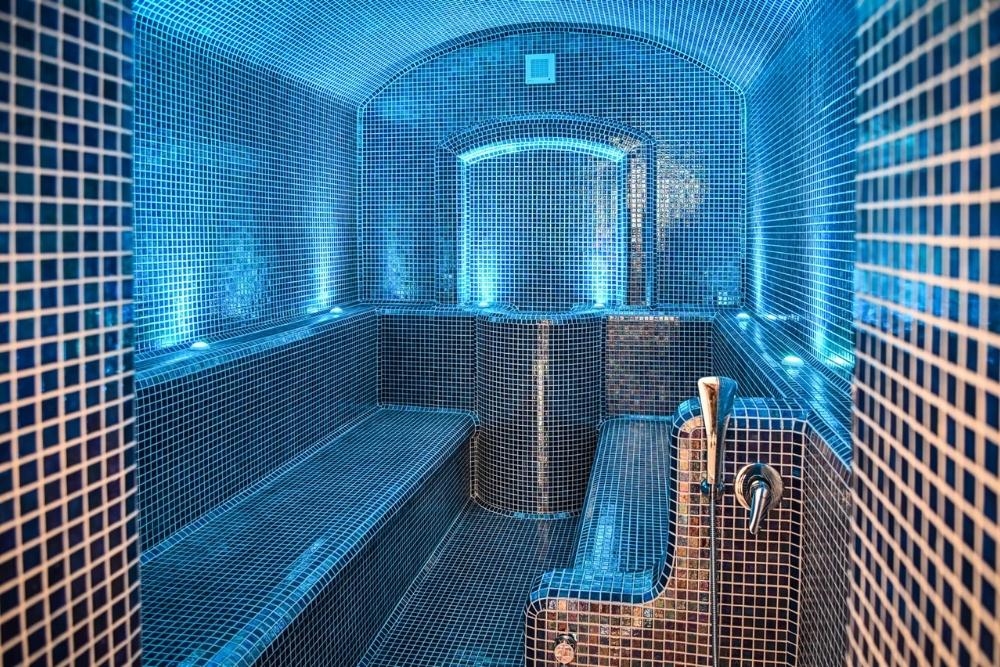
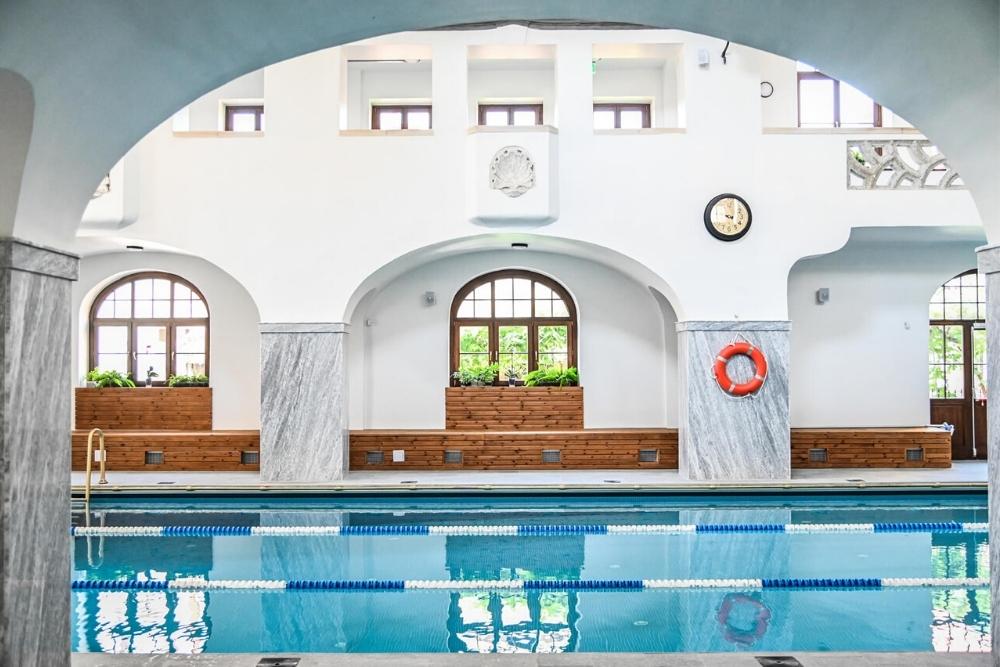
Nowadays, The Sibiu Public Bath (Baia Populară) can boast of being the oldest spa in Romania. Moreover, following the renovation and modernization process, completed in 2020, the services and facilities offered to bring over 80,000 visitors annually. The Sibiu Public Bath includes a completely renovated swimming pool with a new water filtration system, three modern saunas (one dry, one wet, and one Himalayan salt sauna), three therapy rooms (hydrotherapy, massage, and jade stones), a fitness room, a yoga/pilates/aerobics room, changing rooms, a panoramic terrace, a belvedere point in the former water tower with beautiful views of the city. Access to the interior is by digital wristband, as in any modern spa.
Address of the Sibiu Public Bath: 2 Andrei Saguna Street, Sibiu. Program: here. Prices: check here.
Tourist attractions for children in Sibiu. What to do with children in Sibiu
If you’re visiting Sibiu with your little ones, you may be wondering what you could see and do with your kids in Sibiu. There are plenty of activities for children in Sibiu, and even if you don’t have a lot of days available, you can still set aside time during your stay to entertain your little ones in a city you visit together. Here’s how and where:
Natural History Museum Sibiu

Founded in 1849 by the Transylvanian Society of Natural Sciences, which included several intellectuals passionate about nature and the natural sciences, the Natural History Museum of Sibiu remained faithful to the principles stated at the time: educating the younger generation in the spirit of knowledge and conservation of nature.
Today, the neoclassical building (built in 1895), which is part of the historical heritage and is located on one of the defensive belts of the medieval city, houses not only the Natural History Museum (part of the Brukhental National Museum), but also two other interesting museums: the Museum of the History of Pharmacy and the Hunting Museum “August von Spiess”.
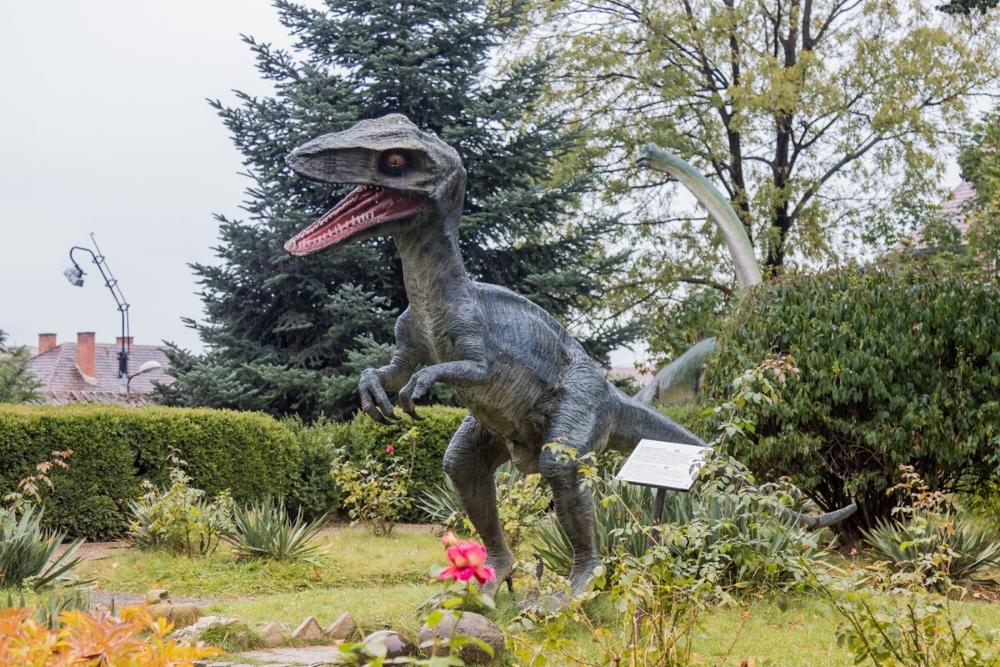
In the museum, children discover a range of interesting information, staged in an attractive presentation with three-dimensional dioramas, with small sound and light effects designed to bring to the fore the evolutionary secrets of the animal world, from invertebrates to ecosystems in various habitats, with forays into the palaeontological era or the area of mineralogy. In the garden, children are surprised by the presence of… dinosaurs.
The museum is open Wednesday to Sunday, 9 am-5 pm (closed Mondays and Tuesdays). Admission: 13 lei.
Steam Locomotive Museum
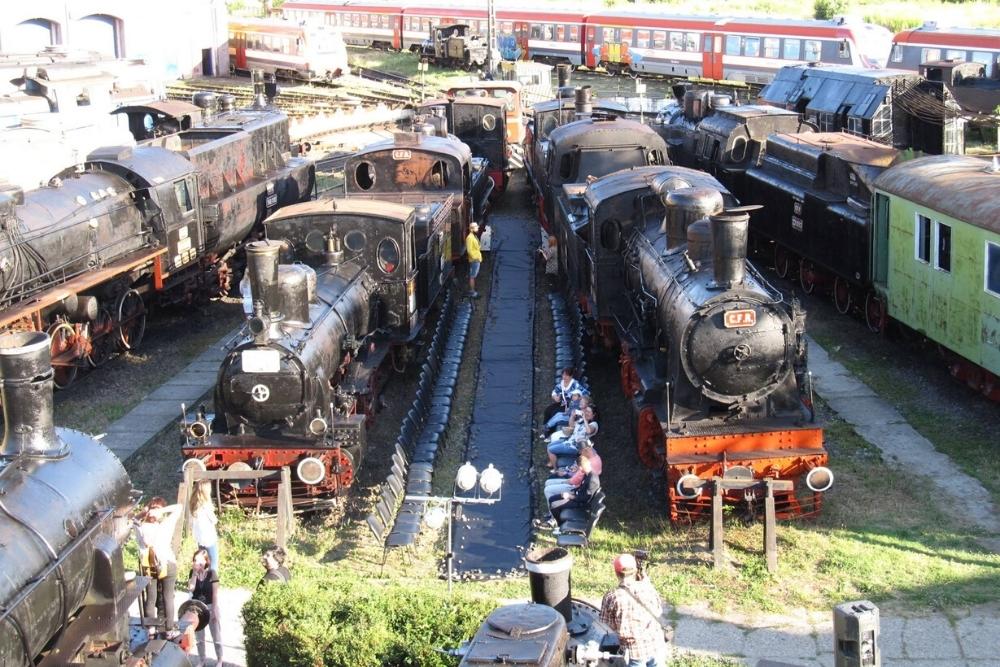
Many boys, in particular, are drawn to trains as children. We don’t know if this is necessary due to the Thomas and Friends cartoons. Still, trains are fascinating, and every little boy has wished to have an electric train at some point in his childhood. That’s why the idea of seeing life-size locomotives might be a great one when you’re in Sibiu and have no idea where else to entertain the little ones.
At the Steam Locomotive Museum in Sibiu, which opened in 1994, you can admire 35 locomotives made between 1885 and 1959 in Germany, the USSR, the USA, and, of course, Romania. Given the age of the exhibits, the place might seem, at first glance, a kind of locomotive ‘graveyard’. Not so, however, and even though admission is free and you can wander freely among the steel giants, you’ll find yourself in a real museum where kids can learn inquisitive facts about trains and locomotives.
Sibiu Zoo

Opinions on zoos are divided, but those who love them will enjoy discovering Sibiu Zoo, a place with a history of almost 100 years, which opened in 1929 in the Dumbrava forest. Spread over 20 hectares, Sibiu Zoo was renovated and modernized in 2006 and is now home to more than 250 animals and birds of over 60 species, from monkeys, white wolves, tigers and lions to parrots, pheasants, and ostriches. Visitors can go boating on the lake in the garden. Admission costs 10 lei (adults) and 5 lei (pupils, students, and pensioners).
Best hotels in Sibiu
We’ve selected the best hotels in Sibiu based on ratings on Booking.com. If you’re looking for accommodation in Sibiu, choose one of these hotels with confidence, and you won’t be disappointed.
5-star hotels in Sibiu
Hilton Sibiu *****
Booking.com rating: 8.6
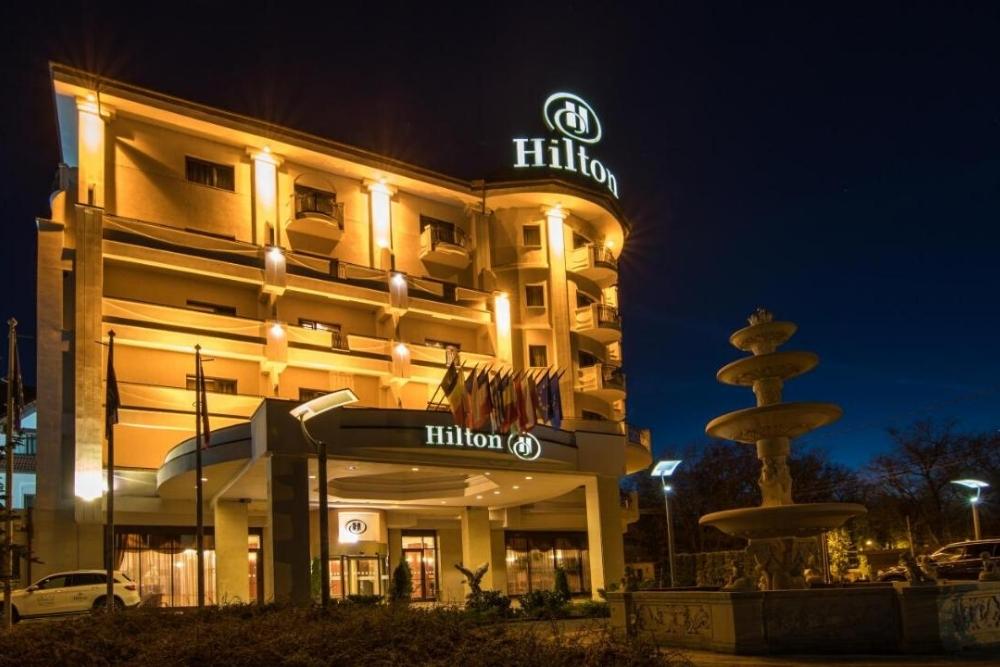
The Hilton is virtually the only five-star hotel in Sibiu (if you exclude villas), the Hilton is just 50 meters from the Astra Museum in Dumbrăvimea Sibiului. The hotel has rooms with mountain views, an indoor pool, a spa with saunas and steam baths, meditation rooms, etc. Add to this two tennis courts and a hair salon. By car, you’re in the city center in 10-15 minutes.
4-star hotels in Sibiu
ART Hotel ****
Booking.com rating: 9.4
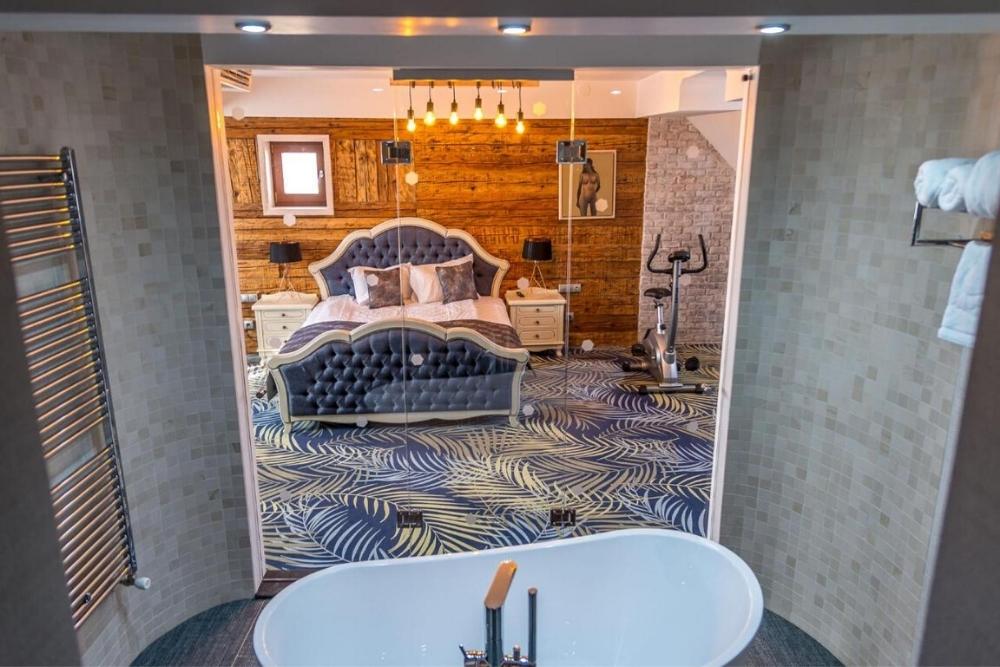
A boutique hotel, ideally placed in Sibiu’s old center, 450 meters from the Council Tower and 270 meters from the Main Square. Bright and spacious, air-conditioned rooms, a buffet breakfast restaurant, bar, and free Wi-Fi.
Exclusive Hotel & More ****
Booking.com rating: 9.2
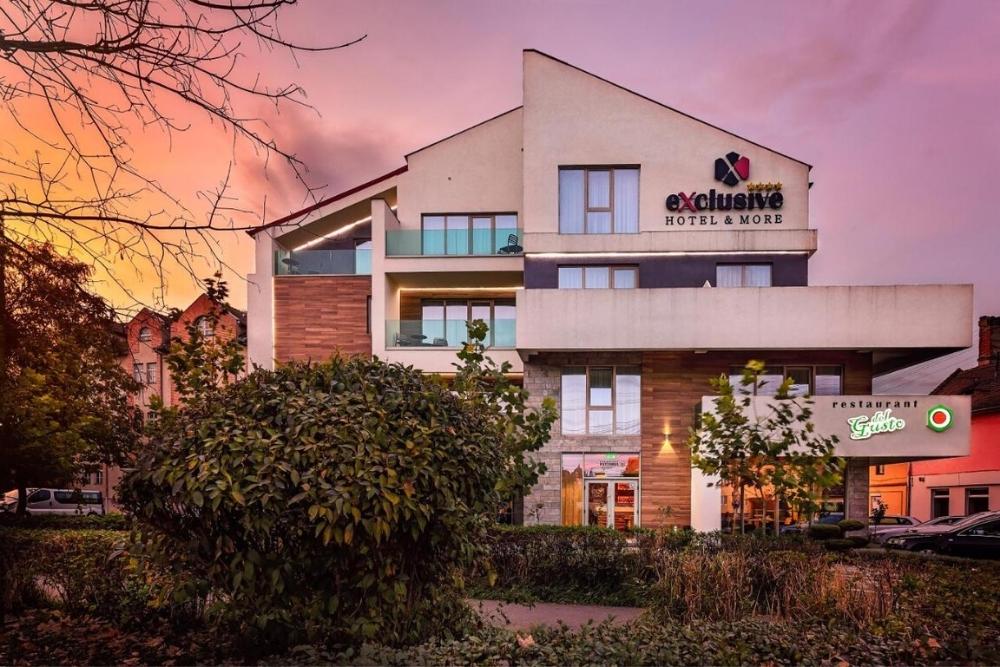
Exclusive Hotel & More is about 800 m from the Liars Bridge and about 950 m from the Great Square and has rooms with city views, air conditioning, and all the necessary amenities. The restaurant serves Italian and international cuisine. Private parking is free.
Hotel Golden Tulip Ana Tower ****
Booking.com rating: 8.9
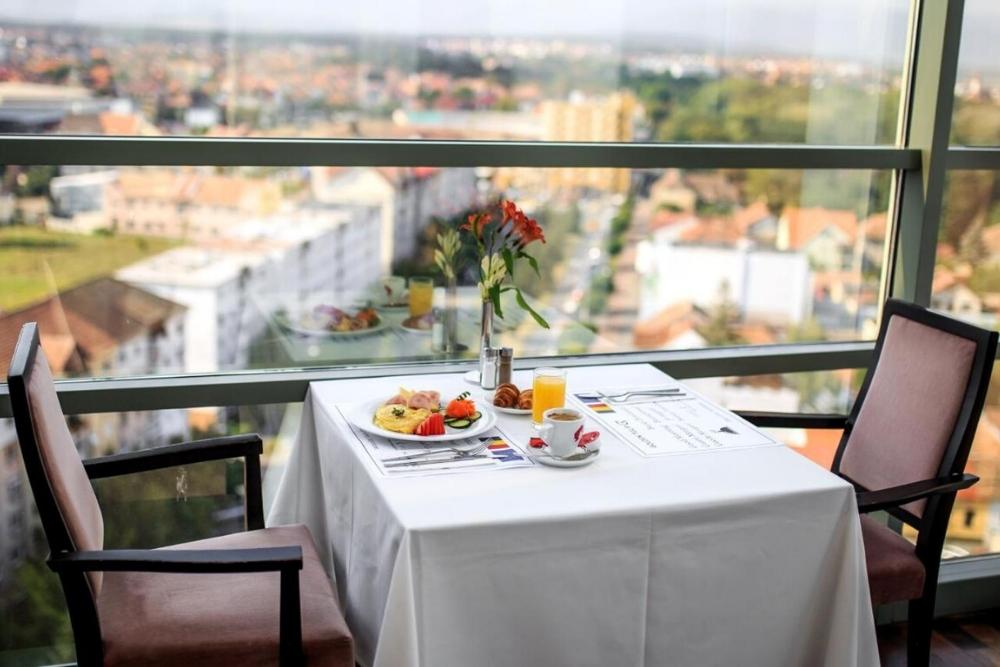
Located in the center of Sibiu, within walking distance of the city’s historic sights (the Grand Square is a 15-minute walk away), the Golden Tulip Ana Tower features modern rooms, spacious bathrooms, and large windows with stunning views of the city and even the mountains. The 585 Fusion Restaurant, on the 11th floor, is highly sought after not only for its dishes but also for the views it offers.
More 4-star hotels in Sibiu
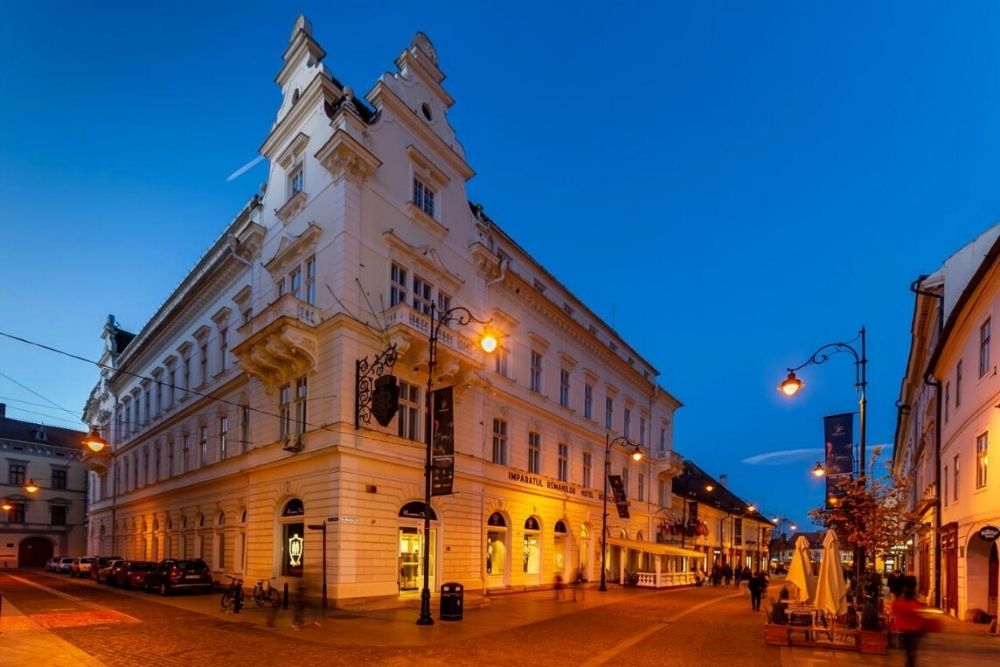
Best Western Silva Hotel **** / Booking.com rating – 8.9 / Book here.
Hotel Stefani **** / Booking.com rating – 8,9 / Book here.
Continental Forum Sibiu **** / Note Booking.com – 8.3 / Book here.
Hotel Împăratul Romanilor **** / Note Booking.com – 8,3 / Book here.
Ramada Sibiu Hotel **** / Note Booking.com – 8,2 / Book here.
3-star hotels in Sibiu
Poet Pastior Residence ***
Booking.com rating: 9.3
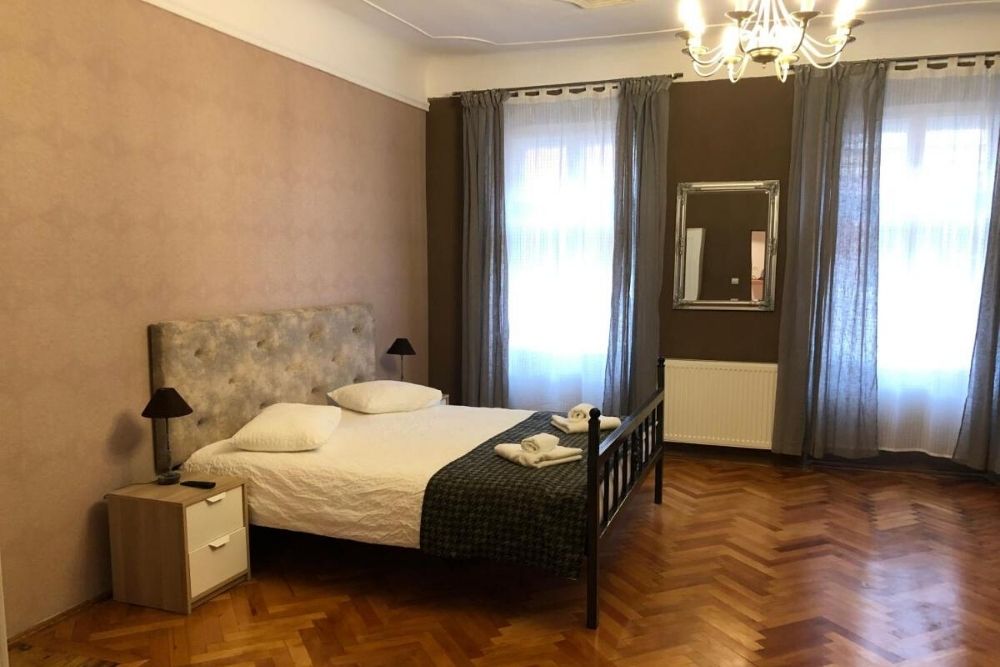
Just 300 meters from the Main Square, a 7-minute walk from the Minciunilor Bridge, and 600 meters from the Stairs Passage, Poet Pastior Residence offers clean rooms with private bathrooms and continental breakfast and is particularly popular with couples visiting Sibiu.
JOYME Hotel ***
Booking.com rating: 9.6
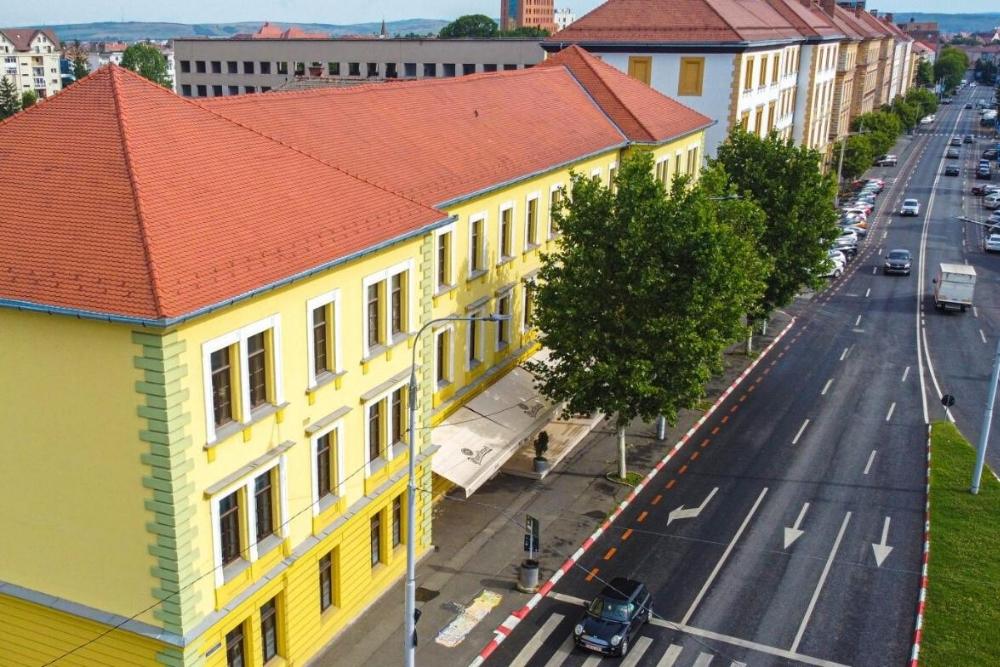
The JOYME Hotel is located in Sibiu’s Old Town, 1.5 km from the Main Square. It offers air-conditioned rooms, a la carte breakfast, free Wi-Fi, free private parking, a terrace, and a bar.
More 3-star hotels in Sibiu
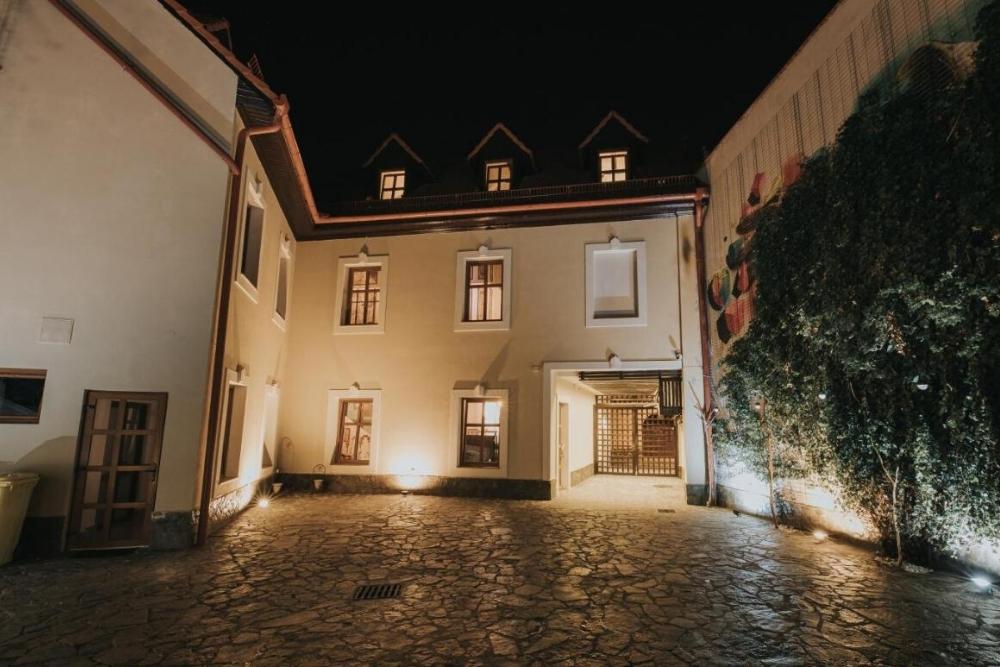
Hotel Marabella *** / Booking.com rating – 9.2 / Book here.
Hotel Premier *** / Booking.com rating – 9.1 / Book here.
Hotel Casa Luxemburg *** / Booking.com rating – 8.9 / Book here.
Best restaurants in Sibiu
Sibiu is known as a city of good food. Many restaurants have opened with various specialties, the menus are diverse, and the dishes are often delicious. If you get hungry in Sibiu, stop by at least one of these restaurants, highly rated on TripAdvisor:
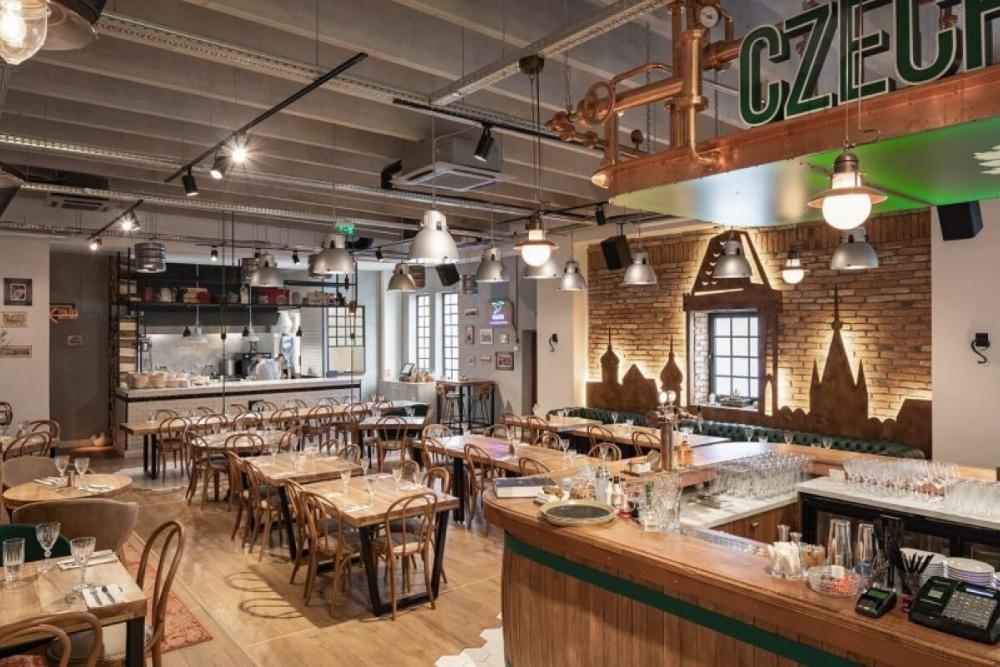
Kombinat Gastro-Brewery
A simple yet intriguing menu using local ingredients from producers in Sibiu county. Kombinat Gastro-Brewery also offers “solutions” for vegetarians, and the beer that is drunk in abundance here is Staropramen.
Address: Str Berariei FN, Sibiu
Old Lisbon Sibiu
A Portuguese restaurant in the middle of Sibiu? Why not? At Old Lisbon Sibiu, dishes such as seafood cataplana or cod in olive oil have the flavor of the original, Atlantic-side dishes.
Address: Târgul Peștelui nr.4, Sibiu
Benjamin Steakhouse & Bar
Benjamin Steakhouse & Bar is a restaurant that aims to make you discover traditional American recipes with beef, among its assortment “shining” the famous Black Angus. So, if you want to enjoy a steak with real taste, come to this steakhouse.
Address: 1 Xenopol Street, Sibiu
Pin it!
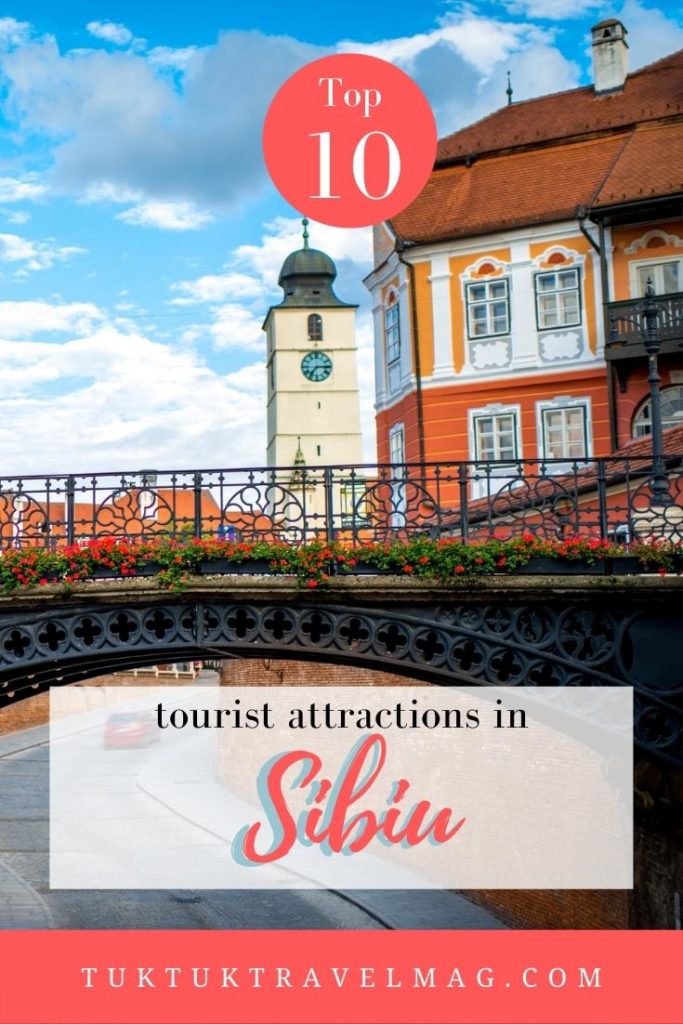
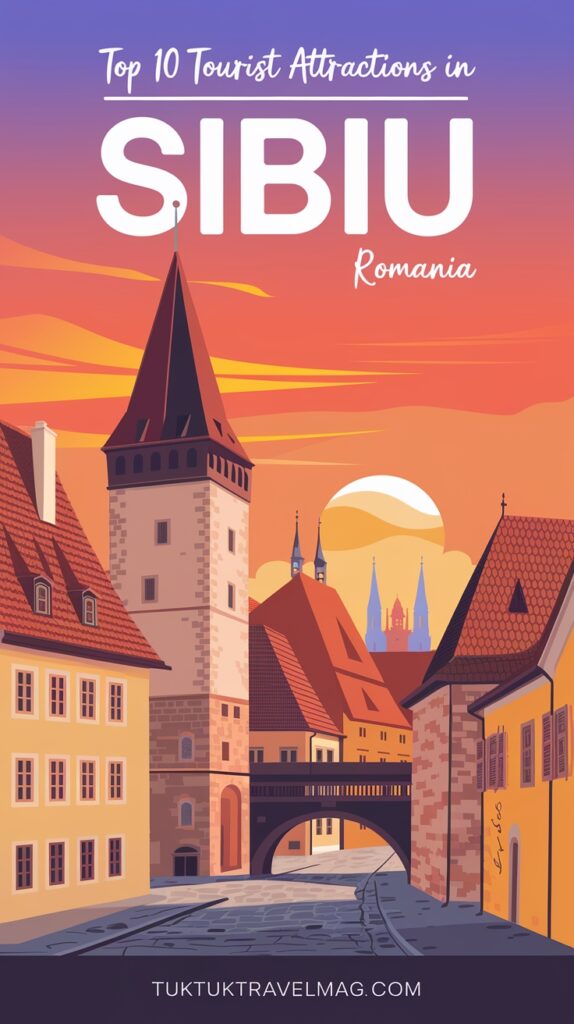
You may also like: Top 10 places to visit in Oradea, the Art Nouveau city of Romania


